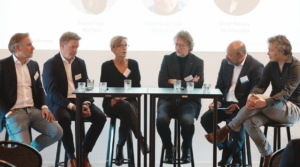If you’re interested in working at Be Informed, you probably want to know what it’s like. We believe that a happy employee leads to a happy team, which results in happy customers. One of our Be Informed heroes, Ronald Heller, tells us about his experience working at Be Informed. And why he’s still passionate about his work after 16 years with us.
Ronald is the principal evangelist/solutions architect at Be Informed. We asked him to tell us about his role.
Enthusiasm For Creativity
Ronald: I strive to combine passion and enthusiasm for Be Informed and related technologies with the creativity to advance discussions among developers, customers, partners, key industry opinion makers, and technologists.
Typically, I am responsible for bringing feedback from customers, partners, and analysts into our product management conversations. What do our customers and partners need, what are their roadmaps, and how can we best support them? I also maintain contact with the analysts in the market who watch trends and developments in the business.
Next to that, I am responsible for the so-called ‘Design Office’. With this team, we take care of the knowledge transfer between projects, partners, and customers. We mainly use Plaza, our online documentation portal, to share patterns and practices. But in the Design Office, we harvest from all projects and perform all sorts of Q&A activities.
As the principal solutions architect, I am involved in many projects, primarily as a coach and sparring partner. But I also tend to be involved in new initiatives, new types of solutions, and business development in general.
Getting Hooked
Have you always had a lot of interest in IT software?
Ronald: Since I was young, I wanted to be an architect—an architect of buildings. But along the way, I turned toward technology…to hardware… to software. This seemed to be my domain. Then the internet came (I’m from ‘77) and was here to stay, and so was I.
The world has become smaller in the sense that everyone is just one virtual meeting away. Seventeen ago (maybe a tad more), I was working on creating big ontologies and linking them together. This was in a completely different space, though. It was all about monumental heritage. The technology and the potential of combining all that data sucked me into ontologies, semantics, and business rules.
I felt this would change how we looked at data and how we could reuse it. My first attempts of reasoning over this linked dataset were exciting, promising, and utterly disappointing, to be honest.
I think that was the moment I got hooked, and that’s when I stumbled upon Be Informed.
My talk at the time with our current CTO was about definitions. We spoke of open-world versus closed-world reasoning, backward and forward chaining, business rules, and who owns them.
An Exciting Beginning
How do you see the changes that have occurred since joining in 2006?
Ronald: Well, my first contact with Be Informed was when it was still a small group of people within the IT service management company Be Value. They were working on an intelligent automation framework that was called Be Informed. The ambition and drive of the team caught me immediately.
In those days, I was a trainer and coach in information analysis and everything XML/SGML, including building big ontologies. This enthusiastic group of people was working on a solution with semantic tech at its core. I could not have been more enthusiastic!
When I joined them a month later, they had just founded Be Informed as a company. Be Informed was a startup but already had years of experience in the field, so we had a running start. Can you imagine how lucky I felt…to be part of that type of journey?
At that time, we had to prove ourselves every step of the way. A small company in the Netherlands with this great notion of decision-driven dynamic case management in a completely model-driven manner. I felt we had to find our place.
Obviously, that has all changed over the years. More parties came into the space. Dynamic case management is established now. Today, model-driven platforms are the way to go. As a company, we evolved as well. In the early years, we still implemented most of our solutions ourselves. We had to; we were relatively unknown. But people found us, and they wanted to use our platform. Now, we have many different partners all over the world in all sorts of business domains. Housed in Apeldoorn, we focus on delivering the best and most usable platform.
Satisfied Customers
What do you think our clients appreciate most about our team and our solutions?
Ronald: As Be Informed is a model-driven platform, it also brings certain characteristics to a project. We start with a team of specialized experts focusing on understanding the customer domain and capturing the business design. We work hard to deliver a platform that supports all phases of a project, including the first phases. Obviously, the ability to capture the business design, scenarios, and requirements is important, but so too is the capability to show previews of the solution.
The platform is only one part of it. We train and actively coach our team to be good sparring partners for the customers and to adopt their vocabulary. Many partners and customers say how much they appreciate this. Our teams dive deep into the domain and really put effort into understanding it and its challenges.
The ability of the platform to return the analysis and design in artifacts—like the catalog, PDF documentation, several diagrams, and a working preview application—is regarded as crucial to a good project. “I can finally see, understand and validate what is happening under the hood” is the feedback from just one of our many customers.
Transparent Decision-Making
The pandemic has disrupted the business world in so many ways. How do you envision the role of technology in the future?
Ronald: I see, increasingly, that we all want to know, need to know, where products come from. We want to know how decisions are made, and we want to be sure that things are done correctly and properly. This is not due to the pandemic per se, but it is clearly a recent development.
It’s called product traceability. It means you want to know how a product came to be through the whole supply chain. Take the example of an item you buy in the supermarket. The label helps you trace where it came from. Although decisions may not seem so tangible, we increasingly demand the same transparency.
Decision-making is core to the work of Be Informed. Supporting decision-makers in their daily work. That’s easier said than done, perhaps. The technology has proven itself in the past decade; we can capture, publish, and execute decisions of various complexity, from the basic to the very complex.

The Ability To Explain
That is only one aspect of it. From this point forward, one of the most important aspects of dynamic case management and decision management is the ability to explain. You need to be able to explain, in a completely transparent way, how you came to these processes and decisions.
I see a change in customers. Previously, you had to be able to explain that you ticked all the compliance boxes for a particular case; a sample-based validation. But this is changing rapidly. You now need to be able to show all cases are compliant all the time and that you actively monitor and can provide evidence for this.
Providing evidence starts at the source, the so-called normative sources, laws, regulations, policies, and the like. Within Be Informed, we capture the norms of these sources in executable models. Other platforms might code these into things like decision tables. Mostly, only the final interpretation of the normative sources is captured, with a link to the originating source if done correctly.
But we lose something here; we no longer see how the interpretation came to be. For traceability purposes, however, this is crucial. There is a need for a strongly supported methodology and open standard for capturing the interpretations of these normative sources.
The methodology and the open standard will bring about supporting applications, hopefully with interoperability capabilities.
Imagine you can exchange your interpretation of a normative source with one of your chain partners. There might even be commercial opportunities here for parties that typically perform analysis of normative sources.
A collaboration with proven impact
Currently, with colleagues and partners like TNO and the Leibniz Center for Law, we work on adopting such a standard. In this case, FLINT (Formal Language for the interpretation of Normative Systems). This effort (in essence, legal engineering) is about combining legal expertise with technical knowledge to create a solution under the working title Policy Workbench.
In this solution, we will support, amongst others, the FLINT methodology and standard. We will capture the discussions on interpretations and use these as the basis for the decision modeling, just as we have always done in Be Informed.
Thank you for your time, Ronald. Let’s get back to that Policy Workbench solution in a separate blog post because there is much more to explore with that.
Do you want to be a part of our IT heroes team? Check out our job openings here.






